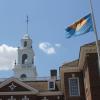Historic marker tells story of Rabbit's Ferry
It's been more than 50 years since the last student attended Rabbit's Ferry School, off Robinsonville Road near Lewes. However, the former one-room schoolhouse has remained vital as a community center.
Delaware Public Archives recognized the role the building has played in the history of the area when it unveiled a historical marker on Dec. 14. It was one of the last active one-room schoolhouses in the state when it closed in 1965.
African-American and Native-American youngsters in the Robinsonville Road area attended the school for 45 years when Delaware schools were segregated.
“This is a special morning,” said Sen. Ernie Lopez, R-Lewes. It was Lopez, Rep. Steve Smyk, R-Lewes, and Speaker of the House Rep. Pete Schwartzkopf, D-Rehoboth Beach, who helped secure funding for the marker. “Thank you for allowing us to play a small role in this.”
Lopez said the marker is also a tribute to the families who attended the school and have lived and worked in the area for generations.
The Rev. Marjorie Burns of Israel United Methodist Church said markers also will be unveiled at two historical African-American churches, Israel U.M Church, near Lewes and Faith U.M. Church in Rehoboth Beach, in the near future.
Funded by Pierre S. du Pont, more than 80 small schools were built across the state from 1918 to 1928 to teach black students. Many of the old schools have been torn down or are in disrepair. Yet Rabbit’s Ferry has remained an important part of the community. Serving as a community center, it is used by groups, including Israel United Methodist Church.
Built in 1920 to replace an older school on the site, Rabbit's Ferry served as a school for 20 to 25 students in grades one through eight, and later for grades one through six, for 45 years.
It was closed in 1965, and students were moved to the Lewes School on Savannah Road. That was 11 years after Brown v. Board of Education, the U.S. Supreme Court case that ended school segregation – the practice of separate but equal education. Delaware was one of the defendants in the case.
Danny Wright and his brother, Howard Wright Jr., and Kathy Street all attended the school. Danny said he attended from 1959-1961 in fifth and sixth grade, with three to six students in his class. He said his family had the distinction of living just one house away from the school, so he never had an excuse not to get to school.
Like other African-American students, he attended William C. Jason High School – now Delaware Technical Community College – in junior and high schools. He was a member of the Class of 1967, the last class to graduate from Jason.
Glenden Jackson came from a family of 13 children who attended the school. In 1958, seven members of his family were attending at one time. “We were one-fifth of the enrollment. And we all walked three miles one way each day from our home beside Israel United Methodist Church,” he said.
He brought a clipping from an old newspaper with a photograph of the Jackson children walking to school.
Jackson said the building was one room with no kitchen that exists today. A large chalk board covered the front wall, and the classes were arranged from first grade in the front to sixth grade in the back. “Our teacher would move from class to class as the day moved on,” he said.
The name of the school is reported to have come from an incident that occurred as the school was being built. During a break, as workers from the community sat around eating a picnic lunch, a rabbit ran across the grass.
The workers said it was as if the rabbit was ferrying across the lawn. The name stuck.
Other one-room schools were located in Belltown, Cool Spring and Milton.
Many Nanticoke Indian children in the Long Neck area attended a one-room school also, which is now a museum.
.jpg)

























































